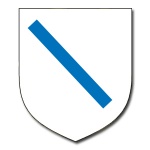Baton: Difference between revisions
From Cunnan
Jump to navigationJump to search
m (format, grammar, category, links) |
(image update) |
||
| (One intermediate revision by one other user not shown) | |||
| Line 1: | Line 1: | ||
== Baton ([[heraldry]]) == |
== Baton ([[heraldry]]) == |
||
[[Image:Baton.jpg|right|150px]] |
|||
<div style="float:right; margin: 0 0 1em 1em;">[[Image:baton.PNG]]</div> |
|||
In [[heraldry]], the '''baton''' is an [[ordinary]] in the shape of a thin diagonal line starting in the [[dexter]] [[chief]], but not reaching the edges of the [[device]]. It is a diminutive of the [[bend]]. If the baton starts in the [[sinister]] chief, it is called a baton sinister. |
In [[heraldry]], the '''baton''' is an [[ordinary]] in the shape of a thin diagonal line starting in the [[dexter]] [[chief]], but not reaching the edges of the [[device]]. It is a diminutive of the [[bend]]. If the baton starts in the [[sinister]] chief, it is called a baton sinister. |
||
Latest revision as of 02:50, 5 March 2006
Baton (heraldry)
In heraldry, the baton is an ordinary in the shape of a thin diagonal line starting in the dexter chief, but not reaching the edges of the device. It is a diminutive of the bend. If the baton starts in the sinister chief, it is called a baton sinister.
By the 17th century a baton sinister was also used to indicate illegitimacy (cf. abatement). This usage is also mentioned as being used in Burgundy in 1463.
Baton (combat)
In fencing, a baton is a walking stick that can be used as a defensive weapon.
